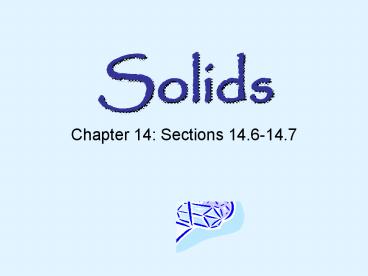Solids - PowerPoint PPT Presentation
1 / 21
Title: Solids
1
Solids
- Chapter 14 Sections 14.6-14.7
2
Review
- What is the main difference between a liquid and
solid? - Are most solids made of only 1 material (such as
an element or compound) or a mixture of materials?
3
Types of Solids
- Many pure substance solids (solids made of only 1
type of atom or 1 type of molecule) form a
crystalline solid - A solid with a regular arrangement of its
components - This produces a highly ordered structure
4
Types of Solids cont
- Salt (NaCl)
- Quartz (SiO2)
- Red Beryl (Be3Al2Si6O18)
- Zircon (ZrSiO4)
5
Types of Solids cont
- There are many types of crystalline solids
- For example, sugar and salt are both solid
crystals, and both dissolve in water - However dissolved salt in water can conduct
electricity and dissolved sugar cannot - That is because salt is ionic and when it
dissolves it is made of charged particles, sugar
is covalently or molecular bonded and does not
conduct electricity
6
Types of Solids cont
7
Molecular representation of diamond.
8
Molecular representation of sodium chloride.
9
A molecular solid.
10
Types of Solids cont
- The properties of a solids are determined by the
TYPE OF FORCES that hold the solid together
11
Bonding in Solids
- Ionic solids
- Fundamental particle are ions
- Ions charged particles
- Have high melting points
- Conduct electricity well
12
Bonding in Solids cont
- Molecular Solids
- Fundamental particle is a molecule (covalently
bonded) - Melts at low temperatures
- Because it has weaker intermolecular forces than
ions - Bonds that are intramolecular are stronger than
intermolecular bonds - Doesnt conduct electricity well
13
Bonding in Solids cont
- Atomic Solids
- Fundamental particle is an atom
- Properties vary greatly
- May be atoms bonded with each other like diamonds
(C atoms bonded with other C atoms, like a GIANT
molecule) - May have little interaction with each other, like
xenon
14
Bonding in Solids cont
- Bonding in Metals
- Metals have very unique properties
- They are ductile (can be pulled into wires)
- They are malleable (can be hammered into shaped)
- They conduct electricity
- The properties indicate that it is hard to
separate metal atoms , but easy to move them past
each other - We call these bonds strong but non-directional
15
Bonding in Solids cont
- Bonding in metals
- The model we use to describe metallic bonds is
called the electron sea model - This describes the metal atoms in a varying sea
of valance electrons
16
Bonding in Solids cont
- The electron sea model explains the easy
conduction of electricity - That atoms can be moved easily but cannot
separate
17
Bonding in Solids cont
- Because of the nature of metallic bonds, it is
easy to make an alloy - An alloy is a substance that contains mixture of
elements that have metallic properties. - There are two types of alloys
- Substitutional alloy
- Interstitial alloy
18
Bonding in Solids cont
- Substitutional alloys
- Some of the atoms of the host metal are replaced
by other metals atoms of similar sizes - Example brass, sterling silver, pewter
19
Bonding in Solids cont
- Interstitial alloy
- Formed when some of the interstices (holes)
between metal atoms are filled with smaller atoms - Examples Steel
20
Bonding in Solids cont
- You should be able to determine the type of
crystalline solid by looking at a substance - Ammonia (NH3)
- Molecular Solid
- Calcium Oxide (CaO)
- Ionic Solid
- Krypton (K)
- Atomic Solid
- Gold (Au)
- Metallic solid
21
Homework
- Read pages 454-461, problems 1-3 on 461. And
problems 43-52 on 465 - Pre-Laboratory Questions for Lab 55 on page 195
of your lab book































